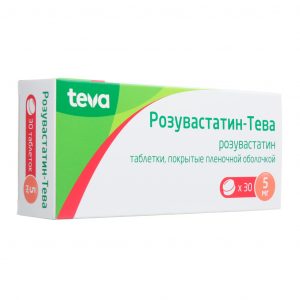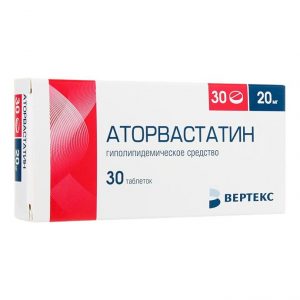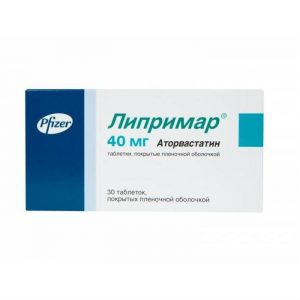Description
Release form
Film-coated tablets.
Packing
30 pcs
Pharmacological action
Atorvastatin – a lipid-lowering drug from the group of statins. The main mechanism of action of atorvastatin is the inhibition of the activity of HMG-CoA reductase, an enzyme that catalyzes the conversion of HMG-CoA to mevalonic acid. This transformation is one of the earliest steps in the cholesterol (cholesterol) synthesis chain in the body. Atorvastatin suppression of cholesterol synthesis leads to increased reactivity of LDL receptors in the liver, as well as in extrahepatic tissues. These receptors bind LDL particles and remove them from the blood plasma, which leads to a decrease in the concentration of LDL-C in the blood.
The antiatherosclerotic effect of atorvastatin is a consequence of its effect on the walls of blood vessels and blood components. Atorvastatin inhibits the synthesis of isoprenoids, which are growth factors for cells of the inner lining of blood vessels. Under the influence of atorvastatin, endothelium-dependent expansion of blood vessels improves, the concentration of LDL cholesterol, apolipoprotein B, triglycerides (TG) decreases, the concentration of HDL cholesterol and apolipoprotein A.
increases. Atorvastatin reduces blood plasma viscosity and blood clotting activity. Due to this, it improves hemodynamics and normalizes the state of the coagulation system. HMG-CoA reductase inhibitors also affect the metabolism of macrophages, block their activation and prevent rupture of atherosclerotic plaques.
As a rule, the therapeutic effect of atorvastatin develops after 2 weeks of using Atoris ®, and the maximum effect is achieved after 4 weeks.
Reliably reduces the risk of ischemic complications (including death from myocardial infarction) by 16%, the risk of re-hospitalization for angina pectoris, accompanied by signs of myocardial ischemia, by 26%.
Indications
Primary hypercholesterolemia (heterozygous familial and non-familial hypercholesterolemia (type II according to Fredrickson).
Combined (mixed) type hyperlipidemia (IIa and IIb types according to Fredrickson) typephenetonium diponetetium diponetetium donebetonephenetinemia dibetetinemia.
Familial endogenous hypertriglyceridemia (type IV according to Fredrickson), resistant to diet.
Homozygous familial hypercholesterolemia with insufficient effectiveness of diet therapy and other non-pharmacological treatments.
Prevention of cardiovascular diseases: Primary prevention of cardiovascular complications in patients without clinical signs of coronary heart disease, but with several risk factors for its development: age older than 55 years, nicotine addiction, arterial hypertension, diabetes mellitus, low levels of HDL-C blood plasma, genetic predisposition, incl. against the background of dyslipidemia.
Secondary prevention of cardiovascular complications in patients with coronary heart disease in order to reduce the total mortality rate, myocardial infarction, stroke, re-hospitalization for angina pectoris and the need for revascularization.
Use during pregnancy and lactation
The drug Atoris ® is contraindicated during pregnancy and during breastfeeding. Animal studies indicate that the risk to the fetus may exceed any possible benefit to the mother.
In women of reproductive age who do not use reliable methods of contraception, the use of Atoris ® is not recommended. When planning a pregnancy, you must stop using Atoris ® at least 1 month before your planned pregnancy.
There is no evidence of the release of atorvastatin with breast milk. However, in some animal species, the concentration of atorvastatin in blood and breast milk is similar. If it is necessary to use the drug Atoris ® during lactation, in order to avoid the risk of developing adverse events in infants, breast-feeding should be stopped.
Composition
1 tablet contains:
Active ingredient: atorvastatin calcium – 31.08 mg, (equivalent to 30 mg of atorvastatin, respectively).
Excipients: lactose monohydrate – 175.24 mg MCC – 52.5 mg hyprolose – 6 croscarmellose sodium – 15 mg crospovidone, type A – 15 mg polysorbate 80 – 0.68 mg sodium hydroxide – 1.5 mg magnesium stearate – 3 mg
Film sheath: Opadry II HP 85F28751 white (polyvinyl alcohol – 3.6 mg, titanium dioxide (E171) – 2.25 mg, macrogol 3000 – 1.82 mg, talc – 1, 33 mg) – 9 mg.
and doses of
Inside, regardless of the meal
Before starting the use of Atoris ®, the patient should be switched to a diet that ensures a decrease in blood lipid concentration, which must be observed during the entire treatment with the drug. warning light hypercholesterolemia by exercise and weight loss in obese patients, as well as the underlying disease therapy.
Treatment starts with the recommended starting dose is 10 mg. The dose of the drug varies from 10 to 80 mg once a day and is selected taking into account the initial concentration of LDL-C, the purpose of therapy and the individual therapeutic effect.
Atoris ® can be taken once at any time of the day, but at the same time every day. The therapeutic effect is observed after 2 weeks of treatment, and the maximum effect develops after 4 weeks. Therefore, the dosage should not be changed earlier than 4 weeks after the start of the drug in the previous dose.
At the beginning of therapy and / or during an increase in the dose, it is necessary to monitor the concentration of lipids in the blood plasma every 2 4 weeks and adjust the dose accordingly.
Primary (heterozygous hereditary and polygenic) hypercholesterolemia (type IIa) and mixed hyperlipidemia (type IIb): treatment begins with the recommended starting dose, which is increased after 4 weeks, depending on the response of the patient. The maximum daily dose is 80 mg.
Homozygous hereditary hypercholesterolemia: the dose range is the same as with other types of hyperlipidemia. The initial dose is selected individually, depending on the severity of the disease. In most patients with homozygous hereditary hypercholesterolemia, the optimal effect is observed with the use of the drug in a daily dose of 80 mg (once). Atoris ® is used as adjunctive therapy to other methods of treatment (plasmapheresis) or as the main treatment if therapy with other methods is not possible.
Special patient groups.
Elderly patients.
In elderly patients, the dose of Atoris ® should not be changed.
Impaired renal function.
Does not affect the concentration of atorvastatin in the blood plasma or the degree of decrease in the concentration of LDL-C with the use of atorvastatin, therefore, changing the dose of the drug is not required.
Impaired liver function.
Caution is required in patients with impaired liver function (due to a slowdown in the elimination of the drug from the body). In such a situation, clinical and laboratory parameters should be carefully monitored (regular monitoring of ACT and ALT activity). With a significant increase in hepatic transaminases, the dose of Atoris ® should be reduced or treatment should be discontinued.
Use in combination with other drugs.
If it is necessary to use simultaneously with cyclosporine, the daily dose of Atoris ® should not exceed 10 mg.
Side effects of
From the side of the central nervous system and peripheral nervous system: headache, dizziness, asthenic syndrome, insomnia or drowsiness, nightmares, amnesia, paresthesia, peripheral neuropathy, emotional lability, ataxia, hyperkinesia, depression, depression.
From the sensory organs: amblyopia, tinnitus, dry conjunctiva, disturbance of accommodation, eye hemorrhage, deafness, glaucoma, parosmia, loss of taste.
From the CCC side: palpitations, vasodilation, migraine, postural hypotension, increased blood pressure, phlebitis, arrhythmia, chest pain, vasculitis.
From the hemopoietic system: anemia, lymphadenopathy, thrombocytopenia.
From the respiratory system: bronchitis, rhinitis, dyspnea, bronchial asthma, nosebleeds.
From the digestive system: nausea, heartburn, constipation or diarrhea, flatulence, gastralgia, abdominal pain, anorexia or increased appetite, dry mouth, belching, dysphagia, vomiting, stomatitis, esophagitis, glossitis, gastroenteritis, hepatitis, hepatitis, liver , duodenal ulcer, pancreatitis, cholestatic jaundice, increased activity of liver enzymes, rectal bleeding, melena, bleeding gums, tenesmus.
From the musculoskeletal system: myalgia, arthralgia, back pain, swelling of the joints, myopathy, muscle cramps, myositis, rhabdomyolysis, tendopathy (in some cases with tendon rupture).
From the genitourinary system: urogenital infections, dysuria (including pollakiuria, nocturia, urinary incontinence or urinary retention, imperative urination), cystitis, hematuria, vaginal bleeding, uterine bleeding, urolithiasis, metrorrhagia, epididymitis, libido, impotence, violation of ejaculation.
From the skin: sweating, eczema, seborrhea, ecchymosis.
Allergic reactions: itching, skin rash, contact dermatitis, rarely urticaria, angioedema, anaphylaxis, exudative erythema multiforme, Stevens-Johnson syndrome, toxic epidermal necrolysis (Lyell’s syndrome).
Laboratory indicators: increased serum CPK activity, increased ALT activity, ACT, hyperglycemia, hypoglycemia.
Other: peripheral edema, weight gain, fatigue, fever.
Drug Interaction
Before initiating therapy with Atoris ®, the patient should be prescribed a standard hypocholesterolemic diet, which he or she should follow throughout the treatment period.
Increased activity of liver enzymes in serum may be observed during treatment with Atoris ®. This increase is usually small and has no clinical significance. However, it is recommended to monitor the activity of liver enzymes in the serum before treatment, after 6 and 12 weeks and with increasing the dose of atorvastatin. If there is a threefold increase in ACT and / or ALT activity with VHN, treatment with Atoris ® should be discontinued.
Atorvastatin can cause an increase in CPK activity and aminotransferases.
In women of reproductive age who do not use reliable contraception, the use of Atoris ® is not recommended. If a patient is planning to become pregnant, she should stop taking Atoris ® at least one month before the scheduled pregnancy.
Patients should be advised that they should consult a physician immediately if unexplained pain or muscle weakness occurs. Especially if they are accompanied by malaise or fever.
Treatment with Atoris ® can cause myopathy, which is sometimes accompanied by rhabdomyolysis, leading to acute renal failure. The risk of this complication increases with the concomitant use of Atoris ® with one or more of the following drugs: fibroic acid derivatives, niacin, cyclosporin, nefazodone, some antibiotics, antifungal agents from the azole group, HIV protease inhibitors.
For clinical manifestations of myopathy, it is recommended to determine plasma concentrations of CPK. With a 10-fold increase, the relative VGN activity of CPC treatment with Atoris ® should be discontinued.
There are reports of atonic fasciitis on the background of the use of atorvastatin, however, the association with the drug may be, but has not yet been proven, the etiology is unknown.
Patients should be advised that they should consult a physician immediately if unexplained pain or muscle weakness occurs, especially if they are accompanied by malaise or fever.
Atoris ® contains lactose, which is why its use in patients with lactase deficiency, lactose intolerance and glucose-galactose malabsorption syndrome is contraindicated.
Impact on the ability to drive and operate vehicles.
Considering the possibility of dizziness, caution should be exercised when driving vehicles and other technical devices requiring increased concentration and speed of psychomotor reactions.
overdose
Symptoms: in the development of myopathy followed by rhabdomyolysis and acute renal failure (a rare but severe side effect), the drug should be discontinued immediately.
Treatment: the patient needs to enter a diuretic and sodium bicarbonate solution. Hemodialysis should be performed if necessary. Rhabdomyolysis can lead to hyperkalemia, which requires the administration of calcium chloride or gluconate calcium, infusion of 5% dextrose (glucose) solution with insulin, use of potassium exchange resins. Because atorvastatin is highly bound to plasma proteins, hemodialysis is ineffective.
General activities: monitoring and maintenance of vital functions of the body and prevention of further absorption of the drug (gastric lavage, administration of activated charcoal or laxatives).
Storage conditions
At a temperature not exceeding 25 ° C, in the original packaging.
Keep out of the reach of children.
Active substance
atorvastatin
Terms and conditions
prescription
Dosage form
tablets
Prescribing
13 prescribing
13 for prescribing
13 for prescribing
13 physician
KRKA d.d. Novo mesto AO, Slovenia




